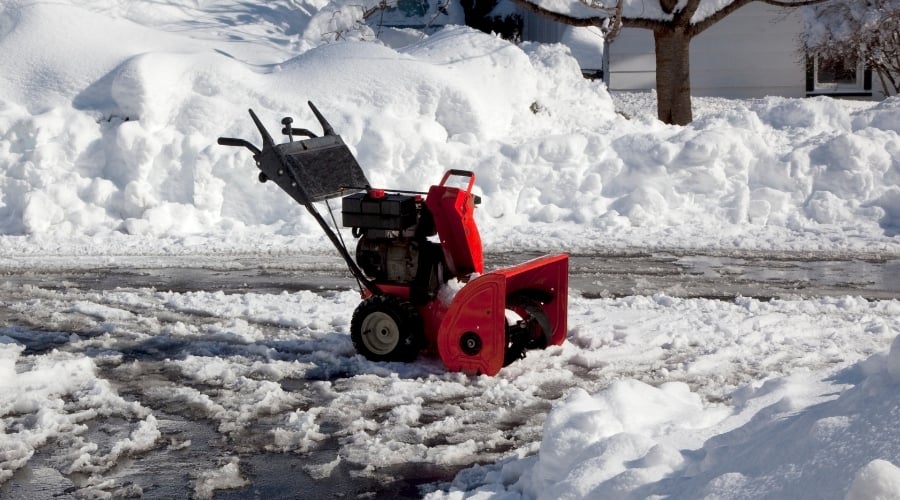Storing a snowblower properly when it’s not in use can save you a lot of time and trouble. Old, undrained gas and other cumulative problems like dirt and debris can cause numerous issues for your machine.
By taking the time to store and care for your snowblower, it will last longer and run more smoothly. Why do snowblowers backfire? Read on, and I’ll explain all the likely causes and share easy fixes as well.
Table of Contents
Why Do Snowblowers Backfire
Snowblowers backfire because there is an issue with the ignition. A dirty carburetor that needs to be cleaned or a degraded spark plug over time may have cracked porcelain, a worn tip, an overlarge gap between electrodes, carbon buildup, or fuel on the end. If the combustion process doesn’t happen smoothly, the result is an explosive-sounding engine backfire.
7 Reasons Why Snowblower Backfires
Some problems have only a single source, but others like a backfiring snowblower come from several potential sources.
Fortunately, in this case, most of the causes are easy to spot. Moreover, you can repair many of these at home without being a snowblower expert.
Below are the top seven reasons why snowblowers backfire:
1. Your Carburetor Needs Cleaning
A dirty carburetor can cause all sorts of problems. Chief among them is backfiring. Cleaning your carburetor should be part of regular maintenance to help your machine run smoothly anyhow. There are two ways to handle this.
First, you can remove the entire carburetor and soak it in cleaning fluid. Meanwhile, the second method doesn’t require pulling the whole carburetor.
Follow the steps below to clean your carburetor without pulling it out completely.
- Gather your tools and materials. You’ll need a can of compressed air, carburetor cleaning fluid, a wire brush, a piece of cloth for cleaning, and a socket wrench.
- Use the socket wrench to remove the adjustment nut holding the carburetor bowl in place. Inspect and clean this first.
- Next, you should remove the float bowl by pulling out the needle and pin. If you hear anything rattling inside or see signs of damage, it’s time to replace this part.
- Then, you need to remove the flathead. Some models allow ample room for this, but others may require you to remove the wheel first.
- Spray your carburetor with cleaning fluid and give it a good scrub with your cloth. Detail the nuts with your wire brush. You can also clean up any tarnished holes with a piece of copper wire, but this step is optional. Finally, use your compressed air to blow out any remaining debris and reassemble everything.
2. Running Lean
A snowblower runs lean when it has too much air or too little fuel in the ignition chamber. This is usually a result of leaving it to sit too long with gas inside.
Luckily the solution is to prime it by squeezing the primer bulb three times, which forces fuel into the carburetor and helps cause ignition. If this doesn’t help, the gas may be old.
3. Old Fuel
Old fuel can certainly cause backfiring in your snowblower. Most of the time, this results from leaving a filled snowblower to sit too long between uses.
You should drain out old fuel entirely before storing it in the future to prevent engine damage.
To fix the old-fuel problem, drain the fuel completely. Once you have removed every drop, replace it with a new fill.
Lastly, you should add a fuel stabilizer and give it a few hours to break down any remnants of the old gas for the best results.
4. Engine Timing Is Off
When the engine timing is off, your snowblower probably has unburnt fuel. If ignition happens before your air vent is entirely open, then it may cause backfiring.
Regrettably, some models that have solid-state ignition aren’t very adjustable and may require professional assistance.
The only adjustment you can make to these is the air gap between the coil and the flywheel. Check your owner’s manual for more information on what your machine’s air gap should be before you change anything.
Standard settings include .0125″ and .030″, so you’ll need to be incredibly precise.
5. Air Valve Blocked
If the air valve is blocked in your snowblower, it may backfire. However, you might also see surging instead or in addition to the backfire issue. Combined surging and backfiring is a good indication you have a valve issue.
The air valve is located in the gas cap, making this the easiest part to diagnose and change. First, loosen the cap and try running your snowblower to see if that ‘solves’ the issue. If it runs problem-free, the valve is blocked.
Sadly, you can’t simply leave the gas cap loose because it will cause excess fuel evaporation. You can try washing or compressed air. If that doesn’t work, buy a new gas cap and toss the old one.
6. Spark Plug Degraded
All spark plugs need replacing eventually, and you should check them after every few hours of use.
A degraded spark plug may have cracked porcelain, a worn tip, an overlarge gap between electrodes, carbon buildup, or fuel on the end. Typically, you can spot these issues with your eyes.
For gap problems, you can use a spark plug gap tool and your owner’s manual to reset the tips of the electrode. You can clean off carbon and fuel.
However, for broken porcelain, rust, or other issues, you should change the sparkplug entirely.
7. Muffler Damage
A snowblower muffler is a simple vent tube. Nevertheless, if this part is broken or bent, it can lead to a buildup inside that causes backfiring.
You should be able to see damage on a muffler by looking at it. However, I recommend grabbing a flashlight for a better view.
Removing and replacing a muffler isn’t precisely a beginner project like changing a sparkplug, though it mainly involves removing screws.
If this is your first time, it’s good to use your owner’s manual and follow a video tutorial like this one that is specific to your make and model.
Helpful Tips To Know About Why Snowblowers Backfire
Don’t let a little backfire frighten you. Learning to self-repair and maintain your snowblower is smart even if you plan to have it professionally serviced instead.
Since you can fix it, you’ll never need to worry about getting snowed in and not being able to reach a repair shop.
Here are a few more helpful tips to know about why snowblowers backfire.
- You may have noticed that snowblowers come in single, two, and three-stage options. A single-stage blower is lightweight and compact because it’s meant for short, flat driveways. Meanwhile, the two and three-stage blowers are for progressively larger snow removal jobs. Choosing the wrong blower can lead to mechanical failure and cause backfiring among other issues.
- Did you know it’s a bad idea to store a snow blower with the key in the ignition? You might expect this to prevent theft but leaving the key in for more than a few days can also impact the battery and engine negatively, leading to more problems like backfiring in the future.
- Lubricating the chute will help throw snow smoothly. Moreover, the snow will go further. Anything you can do to make it easier for your machine to do its job will also help cut down on wear and tear that leads to engine problems and backfiring. Oddly, some people recommend you use spray-on cooking oil for your snowblower chute. However, BobVila suggests WD40 to prevent snow and ice from sticking instead.
Final Thoughts
When your snowblower suddenly backfires, it is loud and alarming. Unlike subtle issues, it’s hard to ignore a backfire, and you shouldn’t.
Whether the cause is a dirty carburetor, bad spark plug, or old fuel that won’t combust properly, it’s essential to fix it promptly.
Leaving your blower to backfire repeatedly will only compound the problem. If you can’t identify a single obvious cause, but there are numerous items that need cleaning and repairs it can cumulatively cause backfiring.
Whatever to root, you should either DIY a solution, or go see a professional as soon as possible and avoid using the machine in the meantime.

